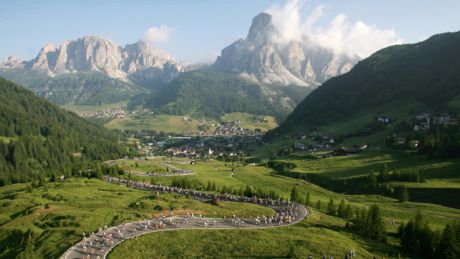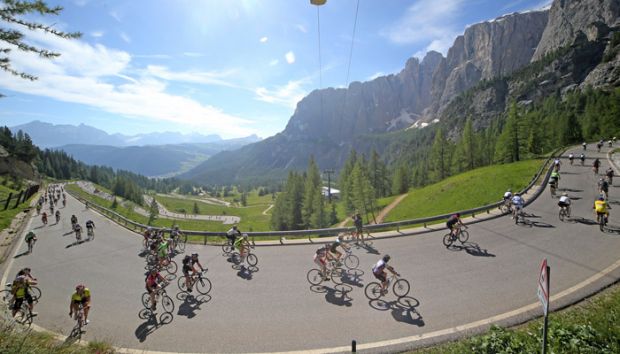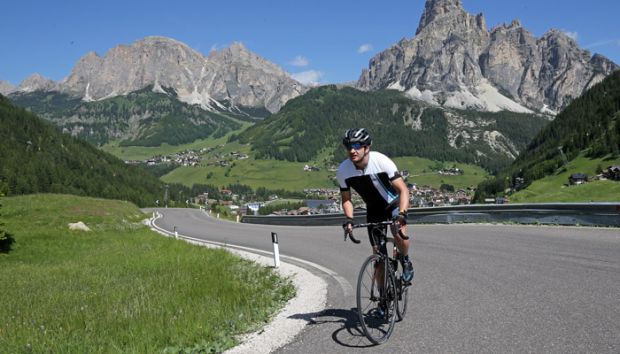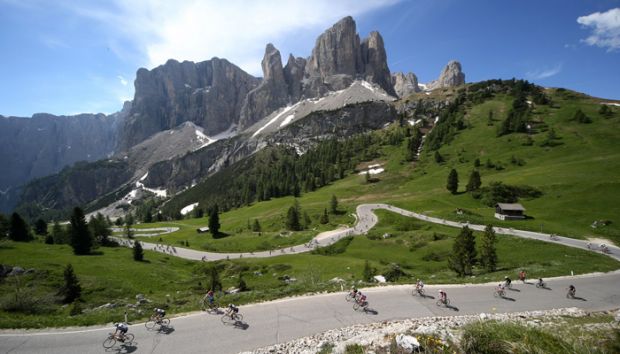The Sella Ronda Challenge
Famous Giro d’Italia climbs, epic mountain scenery and traffic-free roads greet cyclists who brave this bike event

Two hundred and fifty million years ago the jagged peaks and twisted pinnacles of the Dolomites mountain range in northeast Italy lay deep under water, forming part of a spectacular coral reef in the primordial ocean of Tethys. After aeons of immense tectonic activity and volcanic eruptions, the region is now an earthly mountain playground popular with skiers, climbers, hikers and cyclists. But soon after I begin the Sella Ronda bike challenge – a 58km mountain odyssey around the stunning Sella massif in the heart of the Dolomites – it becomes easier to imagine the landscape’s subaquatic past: great shoals of cyclists dart around the mountains and valleys in waves of tropically coloured Lycra; struggling riders slippery with sweat and gasping for air resemble fish freshly plucked out of the sea; and in the middle of them all I myself am frantically frog-kicking my pedals in a bid to swim up the sharp 12% gradients and reach the 2,119m Passo Gardena above.
The Dolomites have been an important part of cycling folklore since 1937 when the Giro d’Italia first ventured into the region. Revered Italian cyclists such as Alfredo Binda, Gino Bartali and Fausto Coppi developed their legendary reputations on the sharp climbs of the Dolomites, which have appeared in the race over 40 times and have regularly marked the Cima Coppi – the highest point of the Giro course.
The Sella Ronda is an annual cycling event in the Alta Badia region which enables amateur riders to go to war with this stunning mountain terrain. The route crosses four mountain passes, including the lofty 2,241m Passo Pordoi, which has represented the Giro d’Italia’s Cima Coppi 13 times, and serves up a leg-shredding 1,750m of vertical ascent.
No cars go
The ride draws its inspiration from the ski circuit of the same name. In winter skiers use a system of ski lifts and slopes to complete a circular journey around the serrated spine of the Sella massif. In summer the equivalent journey by road is popular with motorcyclists and tour groups. But on one Sunday each year the roads are closed to traffic and the route is opened up exclusively to cyclists.

With no cars and motorbikes to dodge, no exhaust fumes to slowly asphyxiate you as you ride, and wide open roads permitting full-gas climbing efforts and speedy descents, the Sella Ronda provides a rare opportunity to tackle the extraordinary Dolomites terrain like a pro rider. Although the presence of 20,000 other cyclists makes the event sound biblical in scale, riders can start at any point along the route and are able to travel at their own pace on the closed roads so the circuit rarely feel claustrophobic.
Following a two-hour flight from Gatwick to Venice, and a three-hour transfer to the UNESCO World Heritage region of Alta Badia, I arrived at my hotel, the rustic Melodia del Bosco, to a pleasant surprise. Hotels in this region are not so much bike-friendly as bike-loving: the Melodia offers everything from lockable storage rooms and bike-washing areas to laundry services, maps and bike rental (owner Klaus Irsara is also a bike guide). However, I took up the chance to visit the Pinarello Passionate Lounge at La Perla hotel in nearby Corvara, where I hired a brand new £10,000 Pinarello Dogma F8 – the bike used by Chris Froome and Sir Bradley Wiggins at Team Sky. My excitement at riding a space-age machine was tempered by the knowledge that I would have no excuses if I flopped on the ride.
It’s about climb
So the following morning, beneath an immaculate summer sky, I find myself eagerly attacking the first climb of the day on the Passo Gardena. The climb is 9.6km long with a vertical gain of 600m, an average gradient of 6.2% and thigh-stabbing bursts at 12%. After a gentle start to the day when I carve through picturesque mountain meadows dotted with wooden chalets, the grey Tarmac soars skywards and even on this slick carbon-fibre bike my legs are burning. Only when I know I am 3km from the top do I hammer down on the pedals and surge uphill.
Get the Coach Newsletter
Sign up for workout ideas, training advice, reviews of the latest gear and more.
The first descent of the day is quite daunting – partly because I don’t like zipping down mountains at 60km/h, and partly because I’m apprehensive about doing so on a £10,000 bike. But it’s fun to wallow in the mountain scenery. I’ve ridden in the Alps and the Pyrénées but the Dolomites are special because of how open and expansive the views are: you rarely find yourself underneath a tree canopy and the dazzling high-altitude terrain energises you as you ride. I now understand why Everest-conquering legend Reinhold Messner declared, ‘They are not the highest but they are certainly the most beautiful mountains around the world’.

The second climb of the day is a 5.5km ascent to the 2,230m Passo Sella. It has an average gradient of 6.8% and some bursts of 8% in the middle of the climb. At the start a tugging breeze across the open valley makes riding a feather-light bike as much of a muscular challenge as an endurance one. And not for the first time today I find myself in an impromptu race with an Italian rider. Only later do I realise he is riding an electric bike, and sadly not before I’ve decimated my body in a vain bid to beat him. As the road tilts upwards, I pop a hydration tablet to combat the withering heat – but it does nothing to diminish my pain as I grind upwards and onwards.
On the descent from Passo Sella I nearly sandpaper my legs when I take a tight corner too fast, and I’m disturbed to realise I felt more concerned by the prospect of damaging the bike than by wrecking my own body. I watch and learn from the Italian riders whose slick technique makes descending look like an art form. They adhere to all the key rules: braking before the turn, moving wide, aiming for the apex of the bend, keeping an eye on the exit, and accelerating away. Although the heat means I’m not feeling particularly hungry, I force down an energy bar, certain that I will need the sugar later in the day.
Gobble game
Up next is the daunting Passo Pordoi. At 2,241m it is the highest surfaced road pass in the Dolomites and one of the most famous and famous climbs in Giro d’Italia history. Although relatively long at 9km it has a steady 6% gradient so I get into a rhythm of 90rpm and chug along to the top, trying to overtake and gobble up as many other cyclists as I can, like a Lycra-clad version of PacMan. Unfortunately, plenty of fitter riders are gobbling me up. At the summit a fierce wind freezes my sweat-drenched body so I take short pilgrimage to the stone memorial to Fausto Coppi, who won the Giro d’Italia five times, and promptly spin back downhill.
The final climb of the day is a 4km ascent to the 1,850m Passo Campolongo. It’s a short climb but the road kicks up to 12.5% in places and it has an average gradient of 7.4%. After committing carbicide with mounds of bread and pasta in the town of Arabba, the climb seems to take an eternity and I begin to feel queasy. By now I have no rhythm or grace, only a mulish stubbornness. The locals here enjoy the saying pedala forte, mangia bene (‘pedal hard, eat well’) but I fear I’ve only achieved the latter.

When I return to Corvara and complete the Sella Ronda circuit, I feel a satisfying lactic acid burn in my glutes and a giggly dizziness from all the rapid changes in altitude. Nonetheless, I’m keen to finish off this Dolomites cycling adventure with a truly epic challenge: the feared 2,236m Passo Giau.
Giau down
The steepest pass in the Dolomites, the Giau is defended by a relentless 922m ascent, a cruel 9.1% average gradient, and hairpin bends which rise like ramps. But a visiting cyclist simply has to tick it off. After a nervous spin to the start of the climb near the town of Codalonga, the punishment begins.
There are a series of road markers which count down the 10km slog to the top but whether through exhaustion or tunnel vision I simply stop seeing them and the journey from 2km to 8km seems to drag on for eternity. At kilometre three I can hear my heart jackhammering in my chest. By kilometre eight I feel my eyes closing, through oxygen deprivation and sheer fatigue. And by kilometre nine I am convinced I am about to spew all over the mountain.
Ascending the Giau is one of those self-flagellating physical challenges during which you pretend you are heroically battling towards glory, then you reach the top, alone and exhausted, and realise nobody else cares. There are no podium girls, no winner’s jerseys and no medals up here. Instead, when I finally crawl over the wind-lashed summit, an hour after starting the climb, and inhale the sublime mountain views, I am greeted by a bunch of German tourists staring through their car windows at me as though I’m insane.
They’re probably right. I’m not entirely sure why cyclists want to blast up big mountains. But there is something about the stunning scenery of the Dolomites which makes you want to give it everything you’ve got – even if you end up lying in a pool of your own sweat and spittle at the top.
Photography: Freddy Planinschek
More info about Alta Badia here. For accommodation and bike hire visit Melodia del Bosco (from around £43 a night) or Hotel Laperla (from around £182 a night). Flights from London Gatwick to Venice Marco Polo start from £125 return. British Airways, Monarch and EasyJet all fly to Venice.
Mark Bailey is a features writer and interviewer who contributed to Coach magazine in 2015 and Men’s Fitness UK, which predated, and then shared a website with, Coach, until 2019. Mark has also written for national newspapers including The Telegraph and The Financial Times Magazine, as well as magazines and websites such as Cyclist and Bike Radar.
